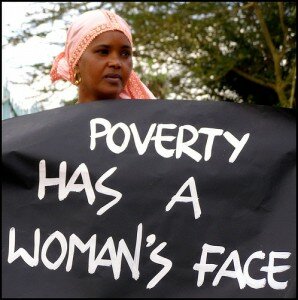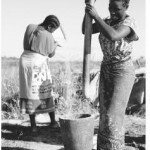Women, the face of poverty: UN needs to redevelop anti-poverty strategy
By Elizabeth Parisian,
Ten years have passed since the UN member nations approved the Millennium Development Goals (MDGs), which represent an ambitious commitment to alleviate poverty and increase wellbeing amongst the least well-off in all corners of the globe. The eight goals each address an aspect of development, from income and hunger to environmental sustainability and eradication of disease, but the most notable feature of the MDGs is the recognition of the critical role of women in achieving these benchmarks.
This should not come as a surprise, given that women bear disproportionately the negative impacts of a globalized economy, and that women of the global South in particular are experiencing increasing burdens of work and care as the conditions of globalization expand their reach. It stands to reason, then, that any attempt to improve the poorest areas of the world will necessarily involve a primary focus upon women, and the MDGs prove to be no exception.
However, there appears to be a significant disparity between creating a women-centered set of development objectives and taking a feminist approach to development. While the MDGs certainly view the education of girls, maternal health, and the empowerment of women to be of primary importance, the goals stray little from traditional development theory. Counteracting the feminization of poverty requires that policymakers go beyond simply targeting women as program recipients and instead take a critical feminist approach to all stages of the development process. As UN leaders meet this month to discuss the disappointing reality that many of the MDGs are not on track to be reached within the next five years, it is ever more apparent that these noble objectives are greatly in need of a feminist re-tooling.
The very idea of creating specific goals with respect to development—with measurable objectives and finite deadlines–is illustrative of the traditional, dominant, and overall androcentric development paradigm. Even the vocabulary of the MDGs—e.g. that poverty is something we must “eradicate” (Goal 1) and that malaria is something we must “combat” (Goal 6)—reflects a very male way of discussing what are overwhelmingly female problems. Feminist theory, in comparison, is reluctant to frame the discussion in terms of benchmarks and timelines. The feminist approach recognizes that poverty intersects with race, class, gender, and region so that it does not “look” the same everywhere, and cannot be subjected to universal measurements. Whereas the MDGs propose measuring poverty by using just a few quantitative indicators, including the $1.25 per day threshold, to feminists, income is simply one of many indicators of extreme poverty.
An agricultural worker in Mozambique and a domestic worker in La Paz, for example, may have the same earned income, but are likely to vary significantly in terms of land ownership, psychological well-being, exposure to environmental degradation and violence, and job security. Viewing development through a feminist lens would illuminate these other important dimensions to poverty and make room for them accordingly in the policy making process. Expanding the definition of poverty is sure to require more expensive and time consuming data collection techniques or difficult to obtain measures, and yet the MDGs would certainly be strengthened—and more achievable—were policymakers to accept the challenge of reformulating definitions and measures of poverty in accordance with a feminist perspective.
That the MDGs take a male-centered approach to addressing the female problem of poverty is also evident in the goals themselves. According to Carol Barton of the Women’s Coalition for International Economic Justice (WICEJ), “The faces of women in the MDGs are predominantly those of a ‘girl child’, a ‘pregnant woman’, and a ‘mother’.”[i] Although poor women in most regions are in fact in great need of maternal care, and virtually all development paradigms now agree that the education of girls is fundamental to addressing poverty, these women also comprise the majority of the world’s low-wage workers. Women living in poverty are not just mothers and girls but workers too, fully engaged in productive and reproductive endeavors, and this does not receive adequate attention within the MDGs; perhaps this has contributed to the fact that the UN describes progress toward achieving gender empowerment and equality to be “sluggish on all fronts.”[ii]
This is not to say that the MDGs do not address issues of income and employment. Goal 1, for example, proposes “To eradicate extreme poverty and hunger” through narrowing the proportion of those living on less than $1.25 per day, decreasing informal employment, and increasing the overall proportion of employed workers.[iii] However, this too represents the traditional economic model in which the worker is assumed to be a single male breadwinner. Aiming to increase formal employment for women may indeed increase their incomes, but women—and poor women in particular—also provide the bulk of unpaid care work, such as caring for infants and the elderly, cooking and cleaning, that is essential to the functioning of the economy. Indeed, according to the UN itself, women’s unpaid work activities, if monetized, would account for more than one third of economic activity.[iv] For the MDGs to be effective, they must embrace feminist economic theory, which suggests that all policy should take into account these critical unpaid care activities, which are disproportionately performed by the poor women of the world, many of whom are also employed in the formal sector.
The MDGs certainly represent an aggressive attempt to address severe poverty across the globe, and the fact that so many of these goals are women-focused is commendable. However, that many of these objectives will not be reached by 2015, particularly for the poorest of the poor, is indicative of the traditional (and ultimately ineffective) economic paradigm used to conceive of and measure these goals from the outset. If women are the face of global poverty, then any attempt to improve their wellbeing necessitates a break from traditional models of development and an embrace of feminist development theory. As 2015 quickly approaches, the UN would do well to seek out feminist knowledge–and Southern feminist knowledge in particular—to help re-frame these important development objectives, so that the MDGs may have a sustainable impact upon the lives of the world’s poor.
–
Elizabeth Parisian is currently a Distinguished University Fellow at The Ohio State University, where she is enrolled in the Rural Sociology graduate program. Elizabeth also works as a research analyst for an international labor union, and began her career in non profit community development.
[i]Women’s Movements and Gender Perspectives on the Millennium Development Goals. Carol Barton, Women’s Coalition for International Economic Justice,
[ii] The Millennium Development Goals Report, United Nations, New York, 2010.
[iii] The Millennium Development Goals Report, United Nations, New York, 2010.
[iv] Human Development Report, United Nations Development Program, 1995.




I agree that African women are probably the population group in the World most affected by Poverty, with their children a short step behind. It also appears that much if not most of the presently implemented relief efforts only succeed in putting more money and luxuries into the pockets of the exploitative political elite and their cronies and have minimal impact on the people really suffering. In my book “To the Poor of Africa, Where are you Going? available on http://www.poorofafrica.com I analyse the motivations that result in this situation and make a few proposals that I believe, when fully developed and implimented will improve matters greatly.
Huguenot
October 10, 2010 at 5:48 am